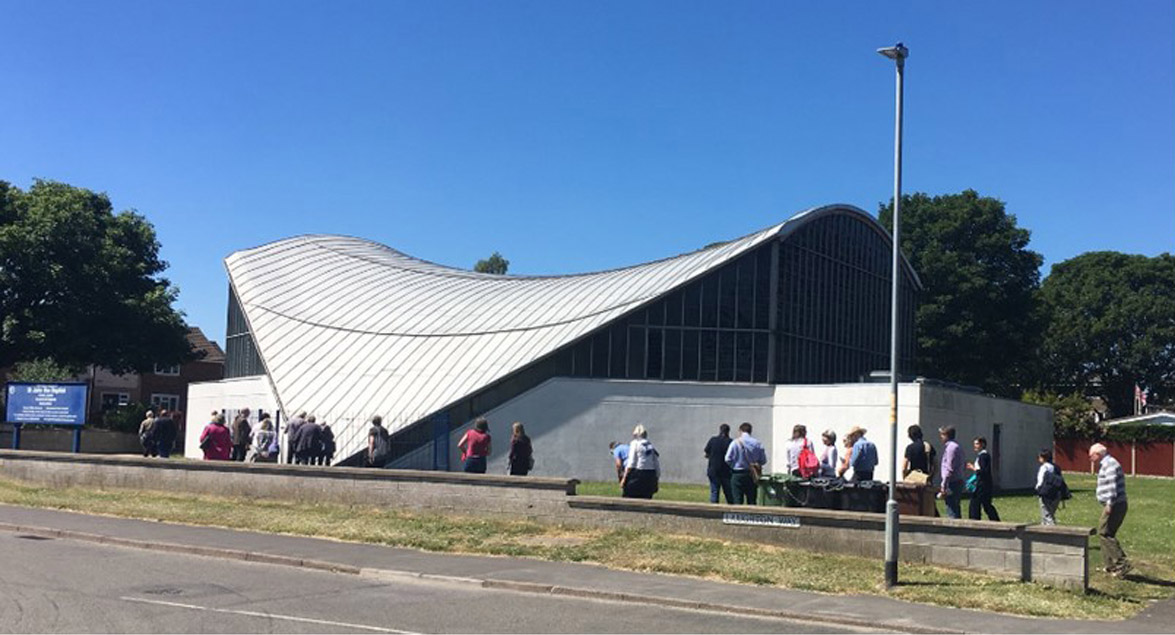
I had a great day out at the EASA Summer Conference
I always find this the perfect time to meet with ‘like-minded’ professionals and the CPD is a chance for me to expand on my knowledge. There is always an amazing story either about the architect of a building that we are visiting or the building itself and this time we heard about the architect Sam Scorer and the stained glass artist Keith New.
I am very aware of the architect Sam Scorer, in fact I have driven by his iconic 1950’s hyperbolic paraboloid petrol station (latterly the Little Chef) on the A1 many a time. He was ingenious with his roof designs and was one of the leading pioneers in the development of ‘hypar’ roof structures in the UK. So I was intrigues to hear the story that went along with his church design at St John the Baptist Church, Ermine. With such a modern building style, maybe one would not expect him to design a church, but he did and very successfully.
The story goes that the community of Ermine wanted to build a new church and the parish priest at the time, John Hodgkinson, happened to sit next to Scorer’s father, who asked if they had selected an architect and preceded to show him a design by his son, Sam. John spoke to Sam and explained that what they lacked in finance (they had no money!) they made up for in enthusiasm and determination and Sam agreed to proceed on the expectation that he would get paid when the design went ahead.
They discussed the purpose and function of the church and the design was drawn up with Sam requesting that £2,000 be put aside for a special piece of art work in the form of a stained glass window by Keith New. Once they had the design they had the arduous task of raising the funds, which they did over time and the church came into fruition.
From the outside it is difficult to imagine what awaits behind the door, and perhaps that’s what he intended
The interior of the church is hexagonal, with the sanctuary being round, sitting everyone together, with the roof leading the eye up towards the heavens and in particular to the East window, full of rich and glorious colour. Taking on board Hodgkinson’s desire ‘not to build a temple, but a tent’, the curved pews are set on a gentle slope facing down towards the centre of the church, encircling a raised altar and in the centre, at the lowest point of the church, the font. All of which is swathed under a large sweeping roof.
Every architect works to a brief and Scorer certainly exceeded his. He symbolises the purpose of the church in an inspiring way, for example the sweeping roof to denote a tent, or stepping down to symbolise stepping into the water of baptism and he incorporates Hodgkinson’s wish for the church to be all inclusive and more of a gathering, with everyone being equal with his circular seating pattern. And the piece of stained glass art by Keith New, who also made windows for Coventry Cathedral, could not work in any other building, it’s raised status, takes the eye up and symbolises the colour and brightness of heaven, but also surrounds people in colour while in church, almost encircling them with God’s love.
Maybe it was the fact that he was so technical that this building works so well, he read Mechanical Engineering at Cambridge before becoming an architect, or maybe it was his deep understanding of both church liturgy and the people in the community that allowed him to realise their vision. One thing is for sure, he did not compromise on the design.

